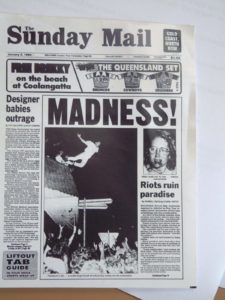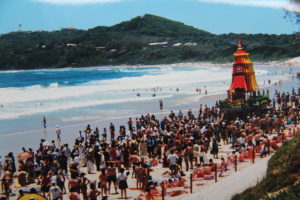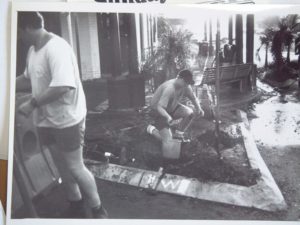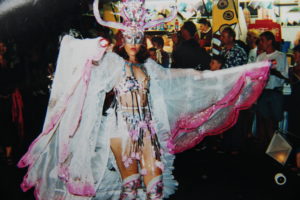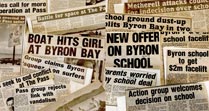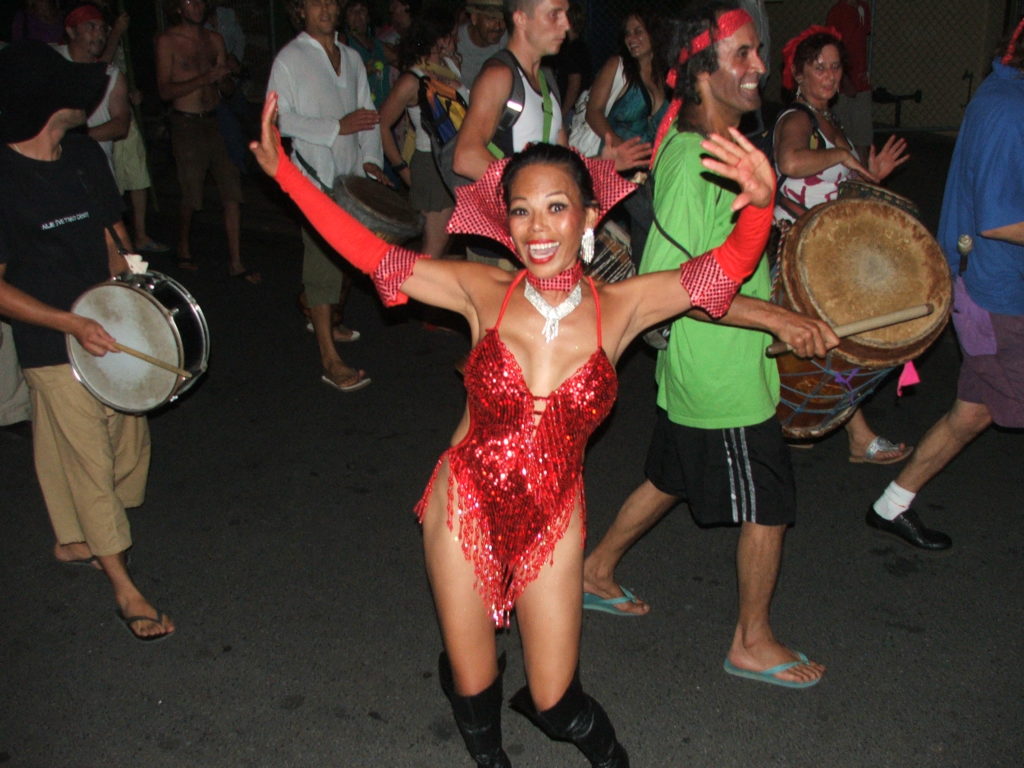
IN my early years at Byron Bay from 1983, New Year’s Eve celebrations at Byron Bay were never a big deal.
It was mostly private parties or going out to dinner, then home.
I remember a lot of people wandering around the streets, many of them drinking, but I really can’t recall any great dramas.
That began to change in the late 1980s, early 1990s with Byron Bay becoming a go-to place to celebrate New Year’s Eve culminating in what is often referred to as the “New Year’s Eve riots” of 1993.
Booze ruled the streets that night with thousands of revellers gathering in the town with the intersection of Jonson and Lawson Streets a focal point, with water spraying from a broken main acting as a magnet.
There were fights and bottles thrown, but more frighteningly, people started jumping off the roof of the then Chinese restaurant and the balcony of The Orient restaurant across the road (today’s The Balcony) into the cheering revellers below.
Not all jumpers were caught safely with some seriously injured.
A photo of one man jumping was featured on the front page of Brisbane’s Sunday Mail two days later with the large headline, ‘MADNESS’.
Under the photo was a story about the night with the headline. ‘Riots ruin paradise’.
It certainly didn’t enhance Byron Bay’s reputation as a safe place to visit.
I had gone home before any of this had happened that night, but I drove into town early the next morning (Jan 1) and Byron Council workers were already trying to clean up the mess. There was little they could do then with the gardens at the roundabout destroyed.
Kevin Jones, who was the police sergeant in charge of Byron Bay Police at the time, later recalled it was the first time New Year’s Eve celebrations had got out of control in the town.
More than 50 police were on duty that night and some were injured during the mayhem which saw60 arrests.
Byron Bay residents, incensed by the trashing of the town and the town’s reputation, joined together to do something about it.
Meetings were called with one of the first – and it may well have been the first – held at the Senior Citizens Hall in Marvel Street, if I recall correctly.
It was a packed meeting of angry residents with many speakers, one of the most forceful being a local builder, Rory O’Halloran.
It was Rory, along with his wife, Annie, who sadly passed away this year, who became the driving forces behind the formation of the New Year’s Eve Safety Committee which led New Year’s Eve festivities for the rest of the 90s, culminating in the Last Night First Light celebrations of 1999 leading into 2000.
Backed by the Byron Bay Lions Club with John Brophy, who also sadly died this year, at the helm, the safety committee spent 12 months planning the celebrations involving the community, Byron Council, police and the State Government.
And what a massive success it was.
An estimated 30,000 revellers who packed the CBD and beachfront were treated to a colourful street parade followed by a fireworks display.
It topped a day of activities which included a parade along the beach by a large Hare Krishna wagon pulled and followed by hundreds of people.
Given the number of people in the town, it was an extraordinarily successful, peaceful and happy night.
The celebrations didn’t come cheap though. All up, they cost $300,000, with the State Government weighing in with $120,000 with the remainder coming from Byron Council and the community.
A host of measures to ensure safe celebrations in the town previously had been introduced including locals’ parking stickers, roadblocks and a temporary mini-bypass across the rail tracks at the southern end of the railway station platform.
The measures were aimed at keeping visitors’ cars out of the CBD and stopping alcohol from being brought into the town by revellers.
Despite the measures, big crowds continued to roll into Byron Bay in following years with the celebrations in 2004 attracting an estimated 30,000 people with about 6000 of that number attending the BayFM dance party in Lawson Street.
Infrastructure in the town was put under massive pressure, particularly in relation to cleaning up mountains of rubbish.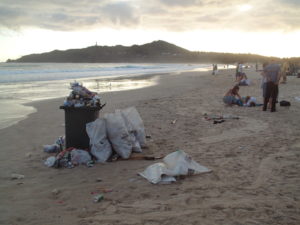
Five months later, Byron Mayor Cr Jan Barham, now deeply involved in the New Year’s Eve Committee, a flow-on from the safety committee, in a bid to ‘reclaim the night’ for locals, said the image of Byron Bay as a ‘party town’ needed to be toned down.
Cr Barham called for the BayFM dance party to be canned to discourage people coming to the town on New Year’s Eve and also for the entire CBD to be an alcohol-free zone which gave police power to confiscate alcohol.
“The town is already full at that time of the year, we don’t need thousands more invading our streets,” she said.
“New Year’s Eve celebrations cost the council money and we want to see that our money is being put to a good cause.”
BayFM’s project manager, Sean Latham, said the dance party was being ‘scapegoated’ as the cause of alcohol-induced chaos.
He said the dance party had been running for 10 years as part of the safety strategy and the problems that had occurred in the town had happened outside the dance zone.
But as it turned out, the dance party was canned for December 31, 2005 and through Cr Barham’s urging, entertainment was toned right down for the night and was specifically aimed at families.
Over the next few years, crowds were well down on the ‘bad old days’ with an estimated 10,000 in town to welcome in 2007 and an even smaller 7000 the following year due mainly to miserable weather.
By 2010 the costs involved with New Year’s Eve at Byron Bay had been slashed dramatically. Gone were the roadblocks, gone were the locals’ stickers which got you through the road blocks and gone was the fear of ‘what’s it going to be like this year’.
Not everyone was happy with the direction of New Year’s Eve activities in the town.
Byron United (chamber of commerce) vice-president, Paul Waters, said the celebrations had become ‘rather dowdy’ and ‘sad’ and needed ramping up.
Mr Waters said he was ashamed and embarrassed that there ‘was nothing going on’, no real celebrations and no countdown to midnight.
Cr Barham hit back urging Byron United to remember the history of New Year’s Eve in the town.
“It’s not about entertainment,” she said. “It’s about community safety.”
The mayor was backed by Annie O’Halloran who suggested that Byron United was looking at turning back the hands of time on safety initiatives.
She said the focus of celebrations which she and Rory had been involved with was on providing a safe environment in the town, not entertainment.
After two ‘low-key’ years, the celebrations on New Year’s Eve 2011 going into 2012 took on a darker tone.
With a crowd estimated between 10,000 – 20,000, there were reports of unruly and drunken behaviour with paramedics reporting a ‘very heavy workload’.
The attraction may well have been the extra entertainment – a band and fireworks – provided by the chamber of commerce, a move opposed by Cr Barham.
Paul Waters, who helped organise the entertainment, saw things differently.
He claimed crowds were well-behaved and there was “much less drama” than previous years.
However, there were many Byron Bay residents left seething with anger over the behaviour of ‘bogan’ visitors over the New Year’s period with fears that the town was again descending to the point that led to the events of 1993.
Rory O’Halloran said perhaps it was time to revisit some of the strategies implemented after 1993.
The town was literally trashed – an all too familiar site at Byron Bay on New Year’s day.
There was so much rubbish left behind that Byron Council’s budgeted $35,000 to clean it up, blew out to almost $45,000.
More than 15.5 tonnes of bottles, rubbish and human waste was collected from the town during and after the celebrations.
The next few years saw the introduction of Soul Street and First Sun events aimed at drawing families into the CBD for New Year’s Eve celebrations.
They were initiated by the Byron Bay Community Centre with support from Byron Council as part of its Safe Summer in the Bay plan.
In 2013, Jonson Street was transformed into Soul Street with a range of low-key activities and entertainment for all the family along with artisan stalls.
However, there was a black mark on the evening when at 11pm a small number of people in the crowd at Main Beach started throwing bottles at police, hitting two officers and smashing a police vehicle window. There were a number of arrests.
Police had the situation under control by midnight.
It was a setback, but Byron Mayor Cr Simon Richardson said the community’s bid to ‘reclaim the night’ had been successful.
It was backed up the following year with an even more successful Soul Street initiative with plenty of fun for kids.
Byron Council’s Cr Paul Spooner said there had not been one New Year’s Eve arrest.
“Byron Bay can now officially be declared a family friendly town,” he said.
And that focus on a family-friendly event continues today.
BELOW: The ‘MADNESS’ headline. Cleaning up after a dance party in Lawson Street. The Hare Krishna wagon making its way down the beach on the last day of 1999. The black and white photo shows council workers cleaning up after the mayhem of 1993. The photo bottom right and top are from the Last Night First Light parade in 1999.
